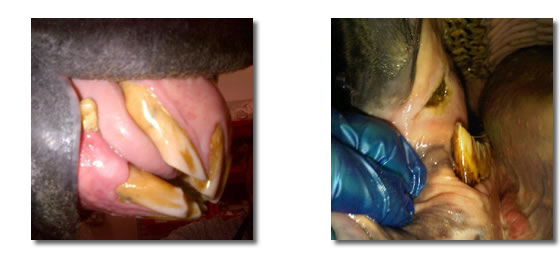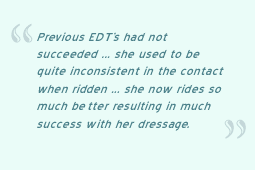
Why Equine Dentistry
Why do horse teeth become sharp?
Horses are categorised as Hypsodont meaning that their teeth constantly erupt throughout their lifetime, and are gradually worn away through eating. Each one of the teeth are made up of three main components: enamel, cementum and dentin.
Enamel is an inert substance which means it is not living tissue and therefore cannot repair itself. Although enamel has high tensile strength it is also brittle. To prevent enamel from chipping or cracking, supporting layers of dentin and cementum absorb the shock applied to the teeth.
Cementum covers the entire external surface of the tooth and protects the enamel. It is a living tissue that has no blood supply after eruption and therefore serves to fill in the surfaces and irregularities.
Dentin protects the enamel components of the teeth and also protects the pulp as it becomes exposed through wear caused by attrition.
The upper molars are large and sit slightly further apart than the lower molars. As the horse chews it wears the teeth away and sharp edges are left on the upper outside and lower inside of the teeth.

What signs indicate my horse needs a dental examination?
- Head shaking, flicking or hanging
- Quidding or dropping feed
- Abnormal chewing action
- Hay washing/dunking
- Weight loss
- Bit evasion and resistance
- Bridling problems or head shyness
- Unbalanced or one sided when ridden
- Facial swellings
- Odorous breath
- Unilateral (one sided) nasal discharge
- Long fibre in droppings
- The horse has not been examined in the last 12 months
Why is equine dentistry important?
With the domestication of horses and ponies we have taken the animal from where it would naturally spend a significant number of hours grazing coarse, low nutrient grasses, and traveling great distances to find food. We have stabled and restricted their ability to roam, consequently changing the type of forage available.
Horses’ teeth are designed to chew tough stalky grasses however we now provide our horses with much softer grasses and feeds and so the teeth do no wear at the same rate that they would do in the wild. This causes sharp enamel points and increases dental malocclusions which, if left to progress, can easily cause soft tissue damage and ulceration thus affecting the horses’ performance and health.
It is therefore vital to recognise the need for a qualified Equine Dental Technician (EDT) as a regular and routine part of horse care to ensure not only the well being of horses but to give them maximum opportunity to perform at their best.












